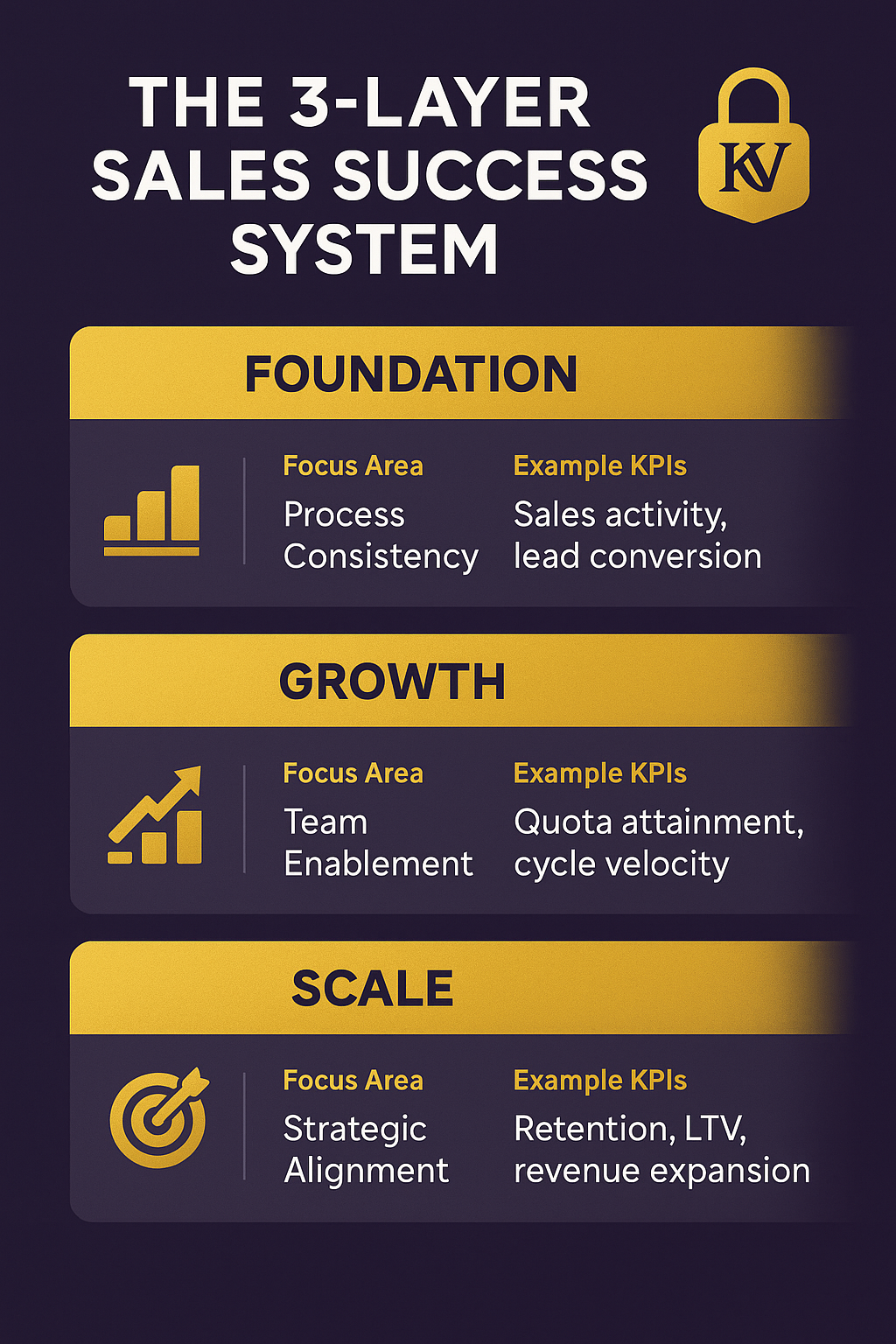
Lorem ipsum dolor sit amet, consectetur adipiscing elit. Suspendisse varius enim in eros elementum tristique. Duis cursus, mi quis viverra ornare, eros dolor interdum nulla, ut commodo diam libero vitae erat. Aenean faucibus nibh et justo cursus id rutrum lorem imperdiet. Nunc ut sem vitae risus tristique posuere.

November 3, 2025
Every business wants more revenue, better conversions, and higher-performing sales teams. But here’s the truth: most companies measure sales the wrong way.
They obsess over numbers, calls made, emails sent, deals closed, without understanding why those numbers matter. Activity doesn’t always equal achievement. Performance without purpose is noise.
That’s where sales success metrics come in. When tracked correctly, they reveal what’s really driving results and where teams are falling short. They give leaders clarity, reps confidence, and companies the insight to scale strategically.
At The Vault Unlocked, Kayvon Kay emphasizes that real sales success isn’t about more hustle; it’s about smarter measurement. Because what gets measured gets mastered.
By the end of this article, you’ll know exactly which metrics matter, how to track them effectively, and how to turn data into decisions that scale growth across your organization.
Sales success isn’t just hitting quota; it’s building a repeatable, predictable system that fuels consistent growth.
The most successful organizations define sales success across three dimensions:
When all three move in sync, your business doesn’t just grow, it compounds.
Before diving into KPIs, it’s essential to build a foundation, a sales measurement framework that connects activity, outcomes, and impact.
Here’s a simple structure used by top-performing organizations:
The mistake most companies make? They track output metrics only, revenue, deals, and profit, and ignore the leading indicators that predict success. Sales success is proactive, not reactive.
The conversion rate is the clearest reflection of how effectively your team turns opportunities into wins. The Formula is:
(Closed Deals ÷ Qualified Leads) × 100
Strong teams constantly optimize conversion at each funnel stage, not just the close.
💡Pro Tip: Compare individual and team rates to spot bottlenecks in your sales process.
CAC shows the cost to acquire a new customer. High-performing sales organizations use CAC not as a finance metric, but as a growth lever. When CAC drops while conversion rates rise, efficiency skyrockets.
The goal is to balance acquisition cost with long-term customer lifetime value (LTV).
LTV tracks the total revenue a customer brings over their relationship with your business. It’s the foundation of long-term growth and a key metric in subscription or high-ticket models.
When your LTV rises faster than CAC, your company’s sustainability skyrockets.
Example: If your average customer spends $2,000 annually and stays for 3 years, your LTV is $6,000. That tells you exactly how much you can afford to invest in acquisition.
💡Pro Tip: Align marketing and retention strategies to raise LTV through loyalty and expansion programs.
Win rate reveals how often reps turn qualified opportunities into actual revenue. It’s one of Kayvon’s favorite success indicators because it blends skill, strategy, and mindset.
To improve win rates, elite sales teams analyze every lost deal for patterns: pricing objections, decision delays, or lack of perceived value.
Kayvon’s insight: “A team that wins 10% more deals doesn’t just sell more, it sells smarter.”
Sales cycle length measures how long it takes from first contact to closing. Shorter cycles drive faster revenue and cash flow, but shorter isn’t always better. The real question is: where does time leak out?
Example: A SaaS team reduced its cycle from 60 to 40 days simply by automating demo scheduling and follow-up emails.
Optimize by removing friction points in approvals, contracts, and post-demo communication.
This metric tracks the effectiveness of marketing-qualified leads (MQLs) in becoming sales-qualified opportunities (SQLs). A low ratio often points to poor lead quality or misaligned messaging, a signal that marketing and sales need to sync.
According to HubSpot, when both departments align, studies show companies can generate 208% more revenue from marketing efforts.
Quota attainment measures how many reps meet or exceed their targets, reflecting performance, morale, and process. If fewer than 60% of your team consistently hits quota, it’s not a talent issue; it’s a training and enablement issue.
Use this metric to assess whether your sales goals are realistic, your onboarding is effective, and your enablement is strong.
Average deal size shows the revenue value per sale. Larger deal sizes suggest better positioning and negotiation, while smaller ones may indicate underpricing or poor qualification.
Example: A real estate firm used deal size tracking to shift focus from volume to value, boosting quarterly revenue by 40% with fewer transactions.
Track deal size by industry, rep, and channel for sharper targeting.
Retention rate measures the percentage of clients who renew or repurchase over a set period. It’s the ultimate proof of customer satisfaction. Companies with strong retention outperform competitors by up to 95% in profitability, according to Bain & Company.
Improve retention by building post-sale relationships, ongoing communication, and success milestones. Repeat buyers are 5x cheaper to retain than new ones.
This measures total revenue or the number of deals closed per salesperson. It’s the single best indicator of team efficiency. Track productivity not to punish low performers, but to understand what your top performers do differently, and teach it.
Kayvon emphasizes that Elite sales teams don’t compete; they collaborate on consistency.
Use analytics tools like Gong, HubSpot, or Close.io to compare activity-to-result ratios and refine training programs.
Numbers alone don’t tell the whole story. Measurement requires context and consistency.
Here’s how high-performing sales teams track success the right way:
Every KPI should ladder up to a core business objective, such as revenue growth, retention, or expansion. Avoid “vanity metrics” that look good but don’t move the bottom line.
Modern CRMs like HubSpot, Salesforce, and Close give leaders real-time dashboards for visibility and accountability. For deeper insights, integrate analytics tools like Gong, Chorus, or Tableau to analyze calls, behaviors, and trends.
Leading indicators (calls made, demos booked) predict future results. Lagging indicators (revenue, win rate) validate success. You need both to optimize continuously.
After every quarter, review metrics with the team. Discuss what worked, what didn’t, and why. This creates ownership and transforms data into a growth strategy.
Tracking success is step one. Scaling is where growth happens. Here are five high-impact strategies to elevate your performance across the board:
Document every part of your sales cycle, from lead generation to follow-up. Automation and playbooks create repeatability, ensuring every rep performs consistently.
According to Harvard Business Review, companies that invest in targeted sales training see a 21% increase in profitability. Ongoing enablement isn’t an expense; it’s an accelerator.
Explore these 5 Corporate Sales Training Programs for scalable team training.
Sales and marketing must operate as one unit. Shared KPIs, content libraries, and communication loops ensure both departments chase the same outcome, not competing goals.
Aligned teams don’t just close more, they close faster.
Use data not just to track reps, but to coach them. Analytics uncover where deals stall, which scripts work, and which objections cause friction. Great leaders turn those insights into playbooks.
Celebrating small wins reinforces momentum. Recognize behavior that drives performance, follow-ups made, demos booked, and relationships built. When culture focuses on progress, results follow.

Sales success isn’t about chasing more leads or bigger quotas. It’s about clarity, knowing precisely what drives performance and doubling down on it.
At The Vault Unlocked, Kayvon Kay teaches leaders that data doesn’t just tell stories, it builds systems that scale.
If you measure what matters, coach what’s measurable, and reinforce what’s repeatable, your sales team won’t just perform, they’ll dominate.
Ready to unlock your sales team’s full potential?
Dive deeper into performance psychology and leadership strategy on The Vault Unlocked Podcast.
No single metric defines success. However, conversion rate and customer retention together give the clearest picture of sustainable growth.
Top organizations review KPIs weekly and analyze trends monthly or quarterly for strategy adjustments.
Efficiency is about speed, how fast your team converts.
Effectiveness is about impact, how well they convert and retain.
Start simple: track conversion rate, average deal size, and retention. Use CRM tools to automate reporting.
Leadership creates the environment for success, aligning goals, removing friction, and empowering teams to execute consistently.

Kayvon Kay
Kayvon has over two decades of experience working with high-level closers and perfecting his sales methodologies. He has earned the title of Canada’s #1 pharmaceutical sales representative and continues to share his expertise as a keynote speaker and through his multi-million-dollar coaching program.